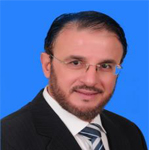CONGENITAL DILATED CARDIOMYOPATHY – A RARE GENETIC CONDITION IN INFANTS
Vol 2, Issue 1, 2018
VIEWS - 9791 (Abstract)
Abstract
A male newborn admitted in the Neonatal Intensive Care Unit due to dyspnea and cyanosis. The baby
was intubated due to tachypnea. No murmurs were heard on auscultation.The ultrasound of the fetal
heart before birth showed cardiac malformations. Chest X-ray showed : Increased pulmonary vascular
markings and cardiomegaly. The abdominal X-ray showed normal liver, spleen and intestine.
Electrocardiogram showed Sinus rhythm and tachycardia.
On the first day after birth, two-dimensional echocardiography demonstrated marked hypertrophy of
both ventricles (the posterior wall of the left ventricle was 33mm thick).
The baby was started on treatment with low flow oxygen support, digoxin and captoril to enhance
myocardial contractility, creatine phosphate for myocardial nutrition , furosemide diuretic to reduced
load, enhance feeding, monitor bilirubin, prevent neonatal jaundice, and close attention was paid to the
disease changes. The baby was stable and was discharged from the hospital. After 20days of discharge,
the baby was admitted again with complains of shortness of breath and cyanosis after 20 days of
discharge. The heart beat was low on auscultation with alternating tachycardia and bradycardia, with an
occasional gallop rhythm. The baby was kept on ventilator assisted ventilation with the required
parameters and necessary investigations were performed.
On repeating the two-dimensional echocardiography, the left ventricular posterior wall and the ventricular
septum was increased compared to the previous echocardiography. A mutation on Chromosome 18,
c.1921G>A was detected on gene mutational analysis. Recently, some genetic studies have shown that
mutations in chromosomes 1, 11, 14 and 15, and mutations in sarcomere proteins genes are autosomal
dominant
Keywords
Full Text:
PDFReferences
- Badertscher A, Bauersfeld U, Arbenz U, Baumgartner MR, Schinzel A, Balmer C.
- Cardiomyopathy in newborns and infants: a broad spectrum of aetiologies and poor
- prognosis. Acta Paediatr. 2008;97:1523–1528.
- Oh JH, Hong YM, Choi JY, et al. Idiopathic cardiomyopathies in Korean children. - 9-Year
- Korean Multicenter Study - Circ J. 2011;75:2228–2234.
- Fahrner JA, Frazier A, Bachir S, et al. A rasopathy phenotype with severe congenital
- hypertrophic obstructive cardiomyopathy associated with a PTPN11 mutation and a novel
- variant in SOS1. Am J Med Genet A. 2012;158A:1414–1421.
- Berger S, Dhala A, Dearani JA. State-of-the-art management of hypertrophic cardiomyopathy
- in children. Cardiol Young. 2009;19(Suppl 2):66–73.
- Eidem BW, Jones C, Cetta F. Unusual association of hypertrophic cardiomyopathy with
- complete atrioventricular canal defect and Down syndrome. Tex Heart Inst J. 2000;27:289–291.
- Livia Kapusta, Nili Zucker, George Frenckel, Benjamin Medalion, Tuvia Ben Gal, Einat
- Birk, Hanna Mandel, Nadim Nasser, Sarah Morgenstern, Andreas Zuckermann, Dirk J. Lefeber,
- Arjen de Brouwer, Ron A. Wevers, Avraham Lorber, and Eva Morava, From discrete dilated
- cardiomyopathy to successful cardiac transplantation in congenital disorders of glycosylation due
- to dolichol kinase deficiency (DK1-CDG), Heart Fail Rev. 2013 Mar; 18(2): 187–196.
DOI: https://doi.org/10.24294/jpedd.v2i2.632
Refbacks
- There are currently no refbacks.

This work is licensed under a Creative Commons Attribution-NonCommercial 4.0 International License.

This site is licensed under a Creative Commons Attribution 4.0 International License.

